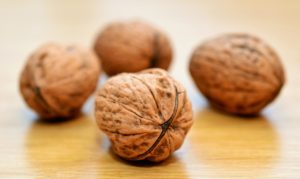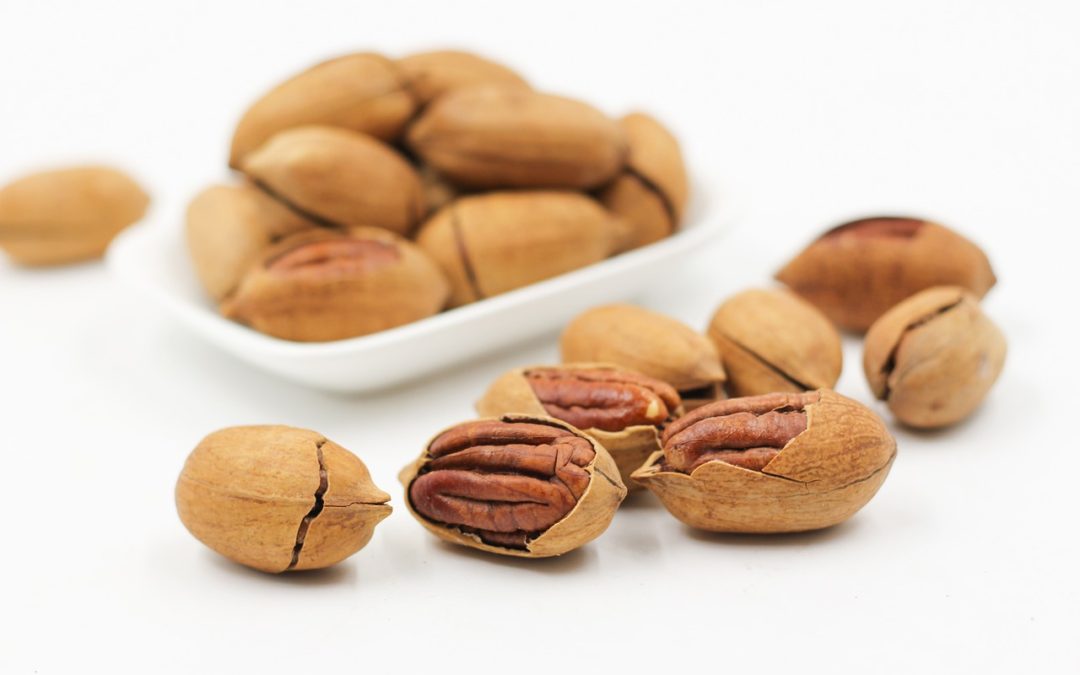Hold on to your hats…this one isn’t too good to be true.
For some of you, this is old news—you already know that including raw nuts in your diet is generally good for your health.
But for those of you who are just learning about this for the first time—Yes!—you really can eat nuts to cut down on headaches (assuming, like any food, that you haven’t specifically determined that they are one of your personal trigger foods).
The idea that nuts are a migraine trigger for everyone is a myth.
Here’s why…
Two of the most common triggers for severe headaches or migraines are:
- Blood-sugar imbalance
- Vitamin or mineral deficiencies
And raw, sprouted nuts are vitamin-packed, mineral-infused, bite-sized bits of goodness that carry an impressive blood-sugar-balancing caloric load that’s rooted in healthy fat and protein.
If you’ve already worked out that nuts don’t agree with you, then of course, continue avoiding them, but don’t dismiss them out of the gate just because you saw them on migraine elimination list. Those lists are definitely not one-size fits all, but rather a starting point for foods to test eliminating out of your diet.
Sounds GOOD!—But which nuts are the best?
Although there is no “best” nut, many people swear by almonds.
For one thing, almonds are delicious.
For another, they’re readily available all over the world.
But more importantly than taste or accessibility is biological impact—almonds are loaded with salicin, a natural anti-inflammatory agent that transforms into salicylic acid inside the body.
(Fun fact—salicylic acid is one of the primary reasons aspirin is so effective as an anti-inflammatory medicine.)
However, some people are allergic to salicylic acid which means almonds (and aspirin) are obviously a no-go for them.
 Fortunately, there are lots of backup options available, including pumpkin seeds, macadamias, sunflower seeds, brazil nuts, pistachios, pecans, hazelnuts, cashews, pine nuts, walnuts, almonds, chestnut, breadnuts, pili nuts, and Gabon nuts.
Fortunately, there are lots of backup options available, including pumpkin seeds, macadamias, sunflower seeds, brazil nuts, pistachios, pecans, hazelnuts, cashews, pine nuts, walnuts, almonds, chestnut, breadnuts, pili nuts, and Gabon nuts.
Incorporate these and other nuts into your diet on a regular basis. Try to eat at least a handful of different nuts three to four times per week, changing up the nut varieties every couple of weeks. Doing so will ensure you don’t encounter dietary boredom, and it will mitigate the risk of developing any unpleasant food sensitivities and help you get a wider range of micronutrients.
(Pssssst—if you’re struggling to keep your raw nut consumption up, try eating them with some fresh fruit, sprinkling them on top of a delicious salad or baked squash, or mixing them in before you serve baked carrots, Brussels sprouts or other veggies.)
Ultimately, you want to try no less than ten different varieties to ensure both your palate and body get well-rounded exposure to what’s out there.
If your local grocery store doesn’t have that many options, that’s OK—online shopping has made purchasing unusual or hard-to-come-by foods (including nuts) easier than ever.
Raw is right
Always aim to get your hands on raw, unprocessed nuts—the closer they are to being “in-shell” the better (soaked or sprouted nuts are the best option).
And read the ingredients because there should only be one—the raw seed or nut! Avoid added oils, or nuts dusted with extras like wheat flour.
And buy certified-organic raw nuts.
Non-organic, commercially processed nuts are usually fumigated with nasty pesticides, herbicides, or fungicides (this is especially true with almonds)—things you absolutely do NOT want in your body.
(Pssssst—If you’re just not a fan of raw nuts and are in need of an alternative—buy raw nuts and then soak and bake them at home. Eat your baked creations either plain or lightly seasoned with wholesome herbs and spices like sea salt, pepper, paprika, cayenne, rosemary, Chinese five-spice, cinnamon, or clove.)
Listen to your body
As you sample different nuts and different seasonings, pay attention to your body.
Everyone digests nuts and seeds a little differently, and some nuts are going to be more naturally suited to your digestive system than others. If you start to experience any gastrointestinal stress that ties into the consumption of a particular nut or seasoning, you may be consuming more than you can handle.
Try ratcheting-back your intake to see if it’s a volume issue.
If you scale back the number of nuts you eat and the problem persists, you may just need to stay away from that type of nut.
(Pssssst—if you have questions about your gastrointestinal system, or how GI-troubles can tie into your migraines, it’s time to set up a Case Review)
Keeping and consuming
 How you store (and when you eat) your nuts matters, so pay attention to expiration dates and storage instructions.
How you store (and when you eat) your nuts matters, so pay attention to expiration dates and storage instructions.
Some types of nuts—like walnuts and pecans—are richer in fats than others, and these fats have an unfortunate tendency to turn rancid with either the application of heat or time.
That means the further removed these nuts are from harvest, the less pleasant they are to taste. If they sit too long in the pantry or on the store shelf, expect them to have a biting, bitter flavor.
Pay attention to peanuts
While you’re welcome to try any number of seeds or nuts in your quest to alleviate the symptoms of your headache, do try to avoid peanuts (easier said than done).
First of all, they’re not a true nut, they’re a legume.
Secondly, most of the peanuts you’ll ever encounter have been processed using unhealthy cooking oils. While raw peanuts exist, they’re not easy to find.
But most importantly, peanuts are frequently contaminated by aflatoxins—poisonous, cancer-causing chemicals that are the byproduct of the fungi Aspergillusflavis.
Taking these three things into consideration, it becomes pretty easy to see why you’re better off avoiding peanuts.
Taking a break
This might be hard to believe, but your body can develop cumbersome food sensitivities if exposed to certain foods too frequently (yes, even healthy foods like nuts).
Although they’re an immune-based reaction, food sensitivities are entirely different from food allergies and require special testing to appropriately diagnose.
If you suffer from headaches when you eat your favorite nuts—and you’ve been eating those nuts regularly for the last two or three years—think about removing them from your diet for at least six months.
 Fighting your headaches with more superfoods
Fighting your headaches with more superfoods
Nuts are just a few of the amazing, headache-fighting foods that you can incorporate into your diet to start feeling better.
If you’d like to learn about some of the other ways to fight headaches through diet—or if you’re simply feeling a little overwhelmed by all of this nutritional information—it’s probably time to set up a call with one of our coaches.
Stay healthy. Stay Amazing.
-Erin
Tried everything and still getting migraines?
A trained Migraine Freedom™ Coach can help!




Hi Erin, great article! I love the idea of treating aches and pains with nutrition rather than medication. So this post fits in perfectly with that. I had no idea that nuts could help with headaches! Next time I get one, I’ll try it 🙂
Thanks so much for the comment, Melanie! Just so you aren’t disappointed when the almonds don’t work like Advil – it is meant to be more of a preventative measure by balancing blood sugar and supplying vital nutrients.
wow. i did NOT know this about nuts, erin! thank you for this valuable information. i love nuts too, so that’s a plus. (and i always have pumpkin seeds on hand as well – one of my favorite snacks.) i just went through a week with several headaches (i believe they were sinus-related). i’m allergic to ibuprofen and aspirin, so i didn’t end up taking anything. next time i’ll know about a natural remedy to cut the suffering!
WOW, Erin, as usual you have jam-packed your post with so much helpful and beneficial information!! I will be passing this on to my two family members who are afflicted with migraines. Fortunately, they both enjoy nuts…although I may have to work on the “raw” part. Thanks for always providing such helpful and actionable advice!!
I know its a late response to this article, but i only recently stumbled across it. Just wanted to toss out some other info thats out there regarding nuts and migraines…
Nuts contain tyramine, which has been proven to be a migraine trigger for many people. Just google it to find out more. Make sure you are aware of this before you run out and start eating nuts as part of your regular diet, if you suffer from migraines.
Are you NUTS?
Nuts are a migraine trigger.
Cute, Arlene. Not everyone has the same triggers and after a trial elimination diet, avoiding every “known” trigger leads to an unnecessarily restricted diet and nutrition. Did you know that “migraine triggers” are simply a list of foods that people have reported problems with over time, many without a clear link to why they cause issues. Sure nuts aren’t for everyone, but that is true whether or not they suffer from migraines.
Treating headaches naturally is a much better idea, in my opinion. I never knew nuts were great for treating headaches.
I had no idea that nuts had to do with headaches. That’s the first time I’ve heard the two connected!
Nuts are one of my favorite things to snack on. I am a big fan of pistachios and peanuts.
Pistachios are my favorite too. They are always good for a movie night.
That is some interesting information. I do love a good, healthy snack!
You have taught me real good, never have known that nut help to avoid headache, thank you so much.
You are welcome.
I had no idea that eating nuts could help reduce headaches. It does make sense, though. I know if my blood sugar is off, I tend to get a headache.
This really makes a lot of sense. I had a friend who used to think she was just prone to migraines. It turns out, she was hypoglycemic, and when her blood sugar went low, it triggered massive headaches.
Thank you for the very informative post about nuts. I didn’t know that nuts are headache-fighting foods, although I know that it has many great health benefits!
How interesting is this! I never thought about nuts for headaches!!! I have to ask my sister if she’s tried this approach because she suffers from headaches – A LOT!
I used to have severe migraines several times a month before I went to a plant-based diet. I am still learning about various foods and their health benefits, so this post is really exciting for me. I will certainly begin to add more nuts into my eating routine.
I’ve been having a lot of headaches lately…going to give this a try! Thanks!
Wow! I didn’t know that nuts would have that good benefits for headache! This is a good read. I’ll share it to my friends who suffer from severe headache.
I honestly did not know that about nuts! Makes me love nuts even more! Thanks for sharing.
I love the idea of having a natural option to alleviate headaches. I will definitely be sharing this information with my friends who suffer from them.
Knew that nuts are good for health but that it can relieve headache is revealing. Will keep handy and try it out next time.
If we have migraine we’re told to avoid chocolate -right? Well my thing has no relation to chocolate. I can eat as much of it as I like and it isn’t my migraine trigger.
So why not the same with nuts?
By the way nuts don’t trigger mine either.
What does is hunger and stress.